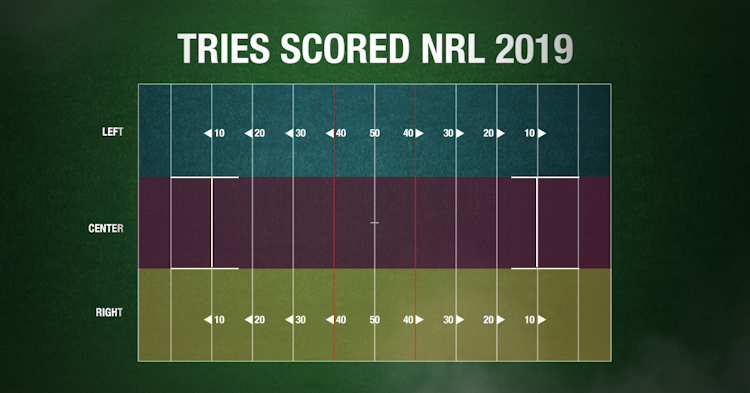Left, Right or Centre: Where each NRL club is scoring tries
Last updated: Aug 7, 2019, 2:38AM | Published: Jul 23, 2019, 12:56AM
As we enter the final third of the season and head toward the finals, it's clear which side of the field most teams target in attack.
For the likes of the Roosters and Storm, the left is the obvious and expected source for most of their tries. The Sharks and Eels, on the other hand, are finding their success predominantly on the right.
Where each NRL club is scoring their tries up to the end of Round 18
Where teams target their attack over the course of a full season can depend on a multitude of factors. Injuries, position changes and general cohesion all play a significant role in where a team focuses their attack.
Here we can see a round-by-round split of where each club has scored their tries throughout the season:
(X Axis - 2019 NRL Round and Y Axis = Percentage of Tries)
Broncos
The Broncos have been scoring on the right side fairly consistently all year but that number took a noticeable dive when Kodi Nikorima left town in Round 8. Despite the inconsistency of who the Broncos have been plugging into the right-side attack since then, they've hovered around their current 41.1%. The difference has been made up through the middle.
Bulldogs
It's no surprise to see the Bulldogs remain relatively consistent in where they score. They only score 2.2 tries per game leaving little room for significant fluctuations. As the club's leading try-scorer with eight tries, Reimis Smith is the beneficiary of the Bulldogs scoring 44.7% of their tries on the right side. The rise of left side and fall of right side tries from Round 8 onward coincides with Lachlan Lewis' dropping.
<ad>
Lewis is named to return this week so we could see a few changes in how Canterbury conducts their attack.
Cowboys
Two things explain the increase in tries scored on the right side and decrease on the left side since Round 8.
John Asiata has been forced to play in the halves with most of his games spent on the left side of the field while Kyle Feldt returned to the right wing in the following round (9).
Introducing a middle forward to the left side in a key playmaking position is always going to have an influence on the effectiveness of that side. So too does having the best finisher in the squad returning from injury on the other. The spread between left (31.9%), middle (21.3%) and right (46.8%) seem to have plateaued and are likely to stick through to the end of the season.
Dragons
It's clear on the graph when Corey Norman fractured his cheekbone.
The steady rise in how many tries came on Ben Hunt's right side flatlined as he spread himself further across the field. A simple lack of tries scored as a result saw the numbers remain the same until the significant spike in Round 13. Norman returned for the Dragons to thump the Bulldogs and resume the prior trend.
Eels
The line displaying Parramatta's left-side attack effectively shows Maika Sivo's progression since debuting in Round 1 this year. The spike in Round 6 coincides with the beginning of Sivo's streak of eight-straight games scoring a try (10 in total).
Brad Takairangi's four tries in two weeks has seen the right side (43%) rise about the left side (35.3%). However, with Dylan Brown working his way back and Takairangi unlikely to keep this pace for much longer, it won't be long before the two lines intersect again.
Knights
Opening the season with Kalyn Ponga at five-eighth didn't help the Knights but where they score their tries has remained fairly consistent since moving him back into the number one jersey. Unlike most clubs that have favoured one side to the other at different points of the season, the Knights haven't swayed more than five percentages points away from the left, right or middle between Round 7 and 18.
Panthers
The inconsistencies of the halves is evident in how many tries the Panthers are scoring on the right side. The recent uptick lines up with James Maloney's temporary move to the right while Jarome Luai occupied the left. With Maloney in form and Nathan Cleary healthy, the two numbers should come closer together in the coming weeks. Likewise, being able to name first-choice centres and backrowers should also help the Panthers continue to increase the number of tries they score on Cleary's right side.
<ad>
Rabbitohs
Cody Walker was the form player of the competition throughout the opening months of the season. You can see exactly where his selection for State of Origin and sequential dip in form occurs, though.

Playing the first 11 rounds with 45.6% of their tries coming on Walkers left side for a 10-1 record, that number has fallen to 37.1% over the last two months.
Raiders
The Raiders love scoring tries on the left side of the field.
Jarrod Croker (7), Jack Wighton (6) and Bailey Simonsson (5) have scored 18 tries between them this season in one of the more surprising left-side attacks in the competition. Famous for the 'Leipana' combination on the right, the Raiders have made the necessary adjustments in the wake of Joey Leilua's season-ending injury and Jordan Rapana's regular stints on the sideline.
Only the Roosters and Storm have scored more tries on the left side than the Raiders.
Roosters
You don't need to see a little graph to know the Roosters score most of their tries down the left side.
While he's only managed 14 games in 2019, Luke Keary is second in the competition in try assists with 18 for the season. Meanwhile, Latrell Mitchell is just one try behind the leader (Sivo) at 13.
The defence knows the Roosters are coming down that side, but still can't stop them.
Sea Eagles
The Sea Eagles attack was all over the place to start the season, but they've found some consistency in where they score over the last two weeks.
Surprisingly, that consistency came when rookie Cade Cust forced his way into the side in Round 10. An ideal partner for Daly Cherry-Evans in the halves, the 20-year-old has scored four tries and handed out six try assists in his seven games. The five-eighth's throughout the 33 games between Round 1 in 2018 and Cust's debut in Round 10 combined for four tries and five try assists.
Sharks
We don't need to delve into the Shaun Johnson blame game again. It's been talked about enough already. However, it's worth pointing out that the Sharks have the best right-side attack in the competition scoring 28 tries.
<ad>
It's no coincidence Johnson's former club held the same honour last season.
Storm
Cameron Munster is the best five-eighth in the game while Brodie Croft might be the worst regular starting halfback in the NRL right now. Seeing the Storm score 43.2% of their tries on Munster's left isn't a shock. Nor is the fact that Melbourne's 32 tries on the left side leads the NRL.
Similar to the Roosters, the opposing side knows where the ball is going but can't stop it from crossing the line.
Titans
Tyrone Roberts is the only player to consistently line up in the Titans spine which has resulted in a whopping 58.3% of their tries coming on his left side of the field. No team scores more of their tries anywhere on the field than the Titans do on the left.

With their attacking structures already predictable and poorly executed, leaning so heavily to one side is a large reason why they rank 14th in attack scoring just 16.7 points per game.
Warriors
Again, Johnson's departure from the Warriors can be seen in where and who is scoring their tries in 2019.
David Fusitu'a led the competition with 23 tries in 2018 but has just four in 14 games throughout 2019. Ken Maumalo, on the other hand, has seen his 2018 tally of five in 23 games rise to 12 in 16 games so far this year. Along with Johnson's departure from the club, Tohu Harris and Peta Hiku switched from the right to the left for this season.
While Kodi Nikorima's addition hasn't sparked a significant improvement in the Warriors, they've done a good job of integrating him while maintaining a potent left-side attack.
Wests Tigers
The Tigers will take tries wherever they can get them this season.
Only the Panthers, Titans and Cowboys have recorded more than Wests' 489 tackles inside the opposition 20-metre line. However, the Tigers rank 12th in attack scoring 12.3 points per game.
Much of that has to do with the sideways attack during Wests good ball sets. As a result, the split between left (42.3%) and right (38.4%) is the closest in the competition.
Did you enjoy this video? Leave a comment below, or join the conversation on the Stats Insider Twitter or Facebook page.




